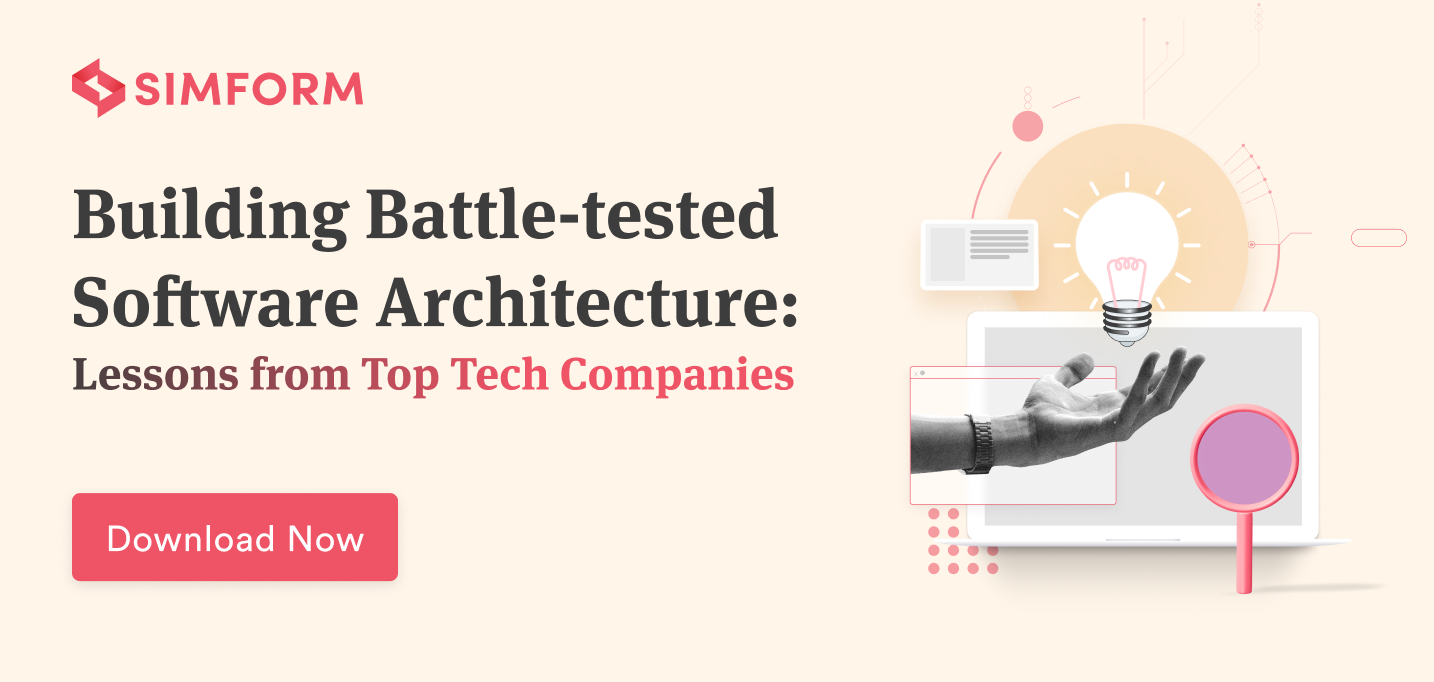Every software project starts with an idea, but how do you turn that idea into a working product? The answer lies in the Software Development Life Cycle (SDLC). The software development life cycle (SDLC) is a conceptual framework that outlines all software development project activities, from planning to maintenance.
To achieve the benefits of SDLC, one must follow a systematic plan as approaching software development problems chaotically may lead to project failure. This article provides an overview of SDLC, its popular models, and how it can help produce high-quality software.
What is SDLC?
Before the 1950s, computing was not elaborate enough to necessitate a detailed approach like the SDLC. However, as the complexity and scale of programming grew, the concept of structured programming emerged within the software industry. This swift-evolution sparked the beginnings of a production framework that eventually evolved into the SDLC.
Software Development Life Cycle is an application of standard practices for developing premium software. SDLC consists of steps such as requirement analysis, estimating feasibility, designing, coding, document, test, deployment, and maintenance. It assists companies in achieving different project goals like faster development, reduction in software development costs, and efficiently catering to customer needs.
How does SDLC works?
The software life cycle clearly outlines every stage of software development by fragmenting the entire process into various phases. It even follows a plan that eliminates bottlenecks of development projects.
This plan starts by evaluating existing systems to find deficiencies, if any. The software is then built through the stages of planning, designing, development, testing, deployment, and maintenance. Here’s an overview of each stage, also called, as phases:
What are the phases of software development life cycle?
Generally, there are four to ten steps in the entire SDLC development process. However, the number of steps may slightly differ as per the applied methodology or the business goals. For instance, the Agile development process uses the iterative workflow, while the waterfall approach is a linear and documented process with terminal phases.
The phases of software development life cycle remain the same from one methodology to another. More or less, they tend to occur in this order in combinations with some techniques or individually. Let’s look at the stages of software development lifecycle methodologies –
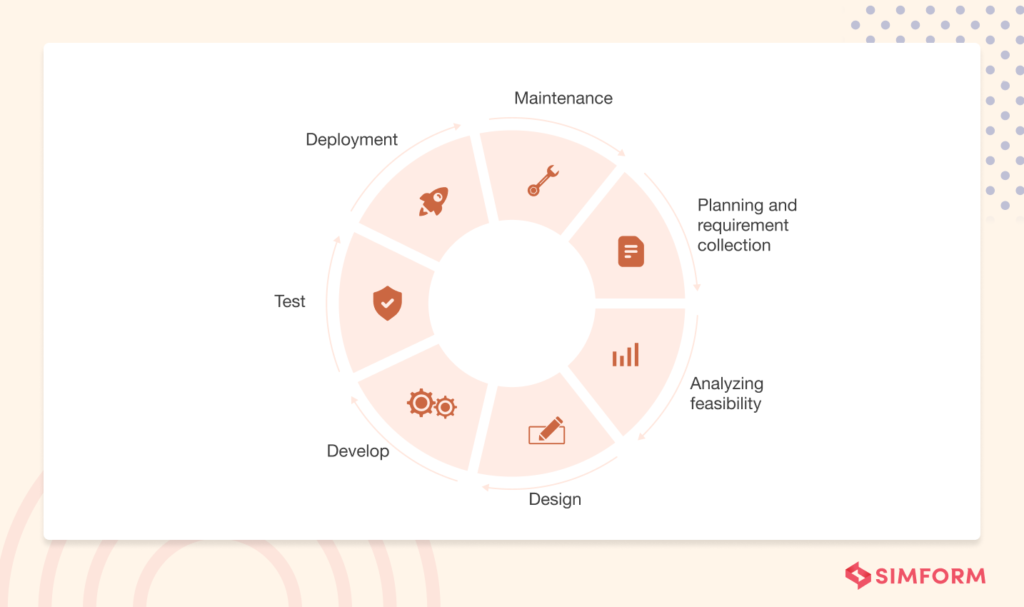
1. Planning and requirement collection
In the planning stage, the team discusses what can go wrong during the development process and derive solutions. Moreover, the team decides and documents the technologies, restrictions, workload, budget, and interaction with third parties.
The specialists meticulously do the task of requirements gathering to present a solution fine-tuned to their needs during the SDLC phase. As a result, developers can clear any doubts in this stage only.
2. Analyzing feasibility
The next phase in the SDLC process is analyzing and documenting the software needs. Also, this process is done with the help of a document called ‘Software Requirement Specification’ (SRS). This document contains almost everything from designing to developing strategies throughout the project.
In the feasibility analysis stage, the development team ascertains that the software is functional, fulfills all users’ requirements, and cannot be replicated in the future. If the software meets these requirements, only then it’s practically, financially, and technically feasible for an enterprise to go ahead with.
3. Design
The design phase includes many things that are broader than just a product designer’s task in software development, getting clear and specific details to visualize the end product and overall software architecture. Then, based on the feasibility analysis, the software development team works on building the product’s design.
In the design phase, developers focus more on the threat modeling process to detect and eliminate possible threats or prepare a mitigation plan. As a result, it becomes easier for software engineering teams to create strategies to address them effectively. Similarly, the product designers work closely with wireframes that act as a reference point between them and the client.
Wireframes assist software engineers in making the development process faster and meeting customer requirements more effectively. In addition, they are an excellent way to test MVP (Minimum Viable Product) and get early feedback to reshape the product as per the client’s requirements.
4. Develop
The software development phase is most likely the longest part of the SDLC process as it requires involvement from the development team to create the final product that contains all the necessary features. However, this approach has guidelines, standards, programming languages, and tools to develop cutting-edge software.
Program development designs should be appropriately assessed in this phase, utilizing internal and external development tools. Initial testing, user training, deployment, acceptance testing, and management approval issues are documented at this stage. Moreover, the development team can also get support from project managers, tech leads, and other professionals to eliminate unexpected bottlenecks within the process.
5. Test
After the development phase, an app’s code gets released into the production environment. Then the quality analysts start looking for errors, bugs, and other possible issues within the software. Next, they check the features against customer expectations and verify the product requirements.
There are multiple testing methodologies for SDLC like integration testing, unit testing, performance testing, system testing, application security testing, etc. Here are the processes that the QA team follows to test the software –
- Planning: During the planning phase of the STLC, all testing strategies are defined. What to test, how the test needs to be done, and who will test it.
- Testing: Testing aims to detect and solve technical issues in the source code and assess the overall product usability and performance. The test engineers perform it in parallel with the development process or at the dedicated testing stage.
Want to know more about end-to-end functionality testing?
- Reporting: The testing logs and test closure reports are prepared and provided to the stakeholders. The team holds a retrospective meeting to document the issues during the development and improve them accordingly.
These steps remain the same in any software testing process, but their duration may vary as per project size and business requirements.
6. Deployment
Now is the time to launch the software in the market. First, developers will take one final look at the new system and then work with content writers and quality assurance professionals to create detailed documentation. Including this, the development team can prepare for the product launch at this stage itself.
In the deployment phase, the software development team is ready to collect and analyze user feedback to get a clear idea of how their product is performing and how they can improve it to boost overall customer satisfaction.
7. Maintenance
Software development is a never-ending process; it continues even after the final product delivery. One needs to upgrade the product as per system requirements and detect bugs to improve the user experience and future enhancements. Moreover, the developers may witness a bug or issue in the live software.
Other than this, tracking and reviewing the network’s performance, environment stability, and product behavior post launching is advisable. As the product has reached the final stage, it needs to be stable and faster. The maintenance phase is significant to meet existing customer needs with ease.
Popular Software Development Life Cycle Models
The Software Development Life Cycle (SDLC) models can provide developers with a robust structure to ensure a smoother transition from the beginning to the end of a project. In addition, the entire SDLC process can be narrowed down to the form of different models that can be used for project-based work.
However, the choice of a suitable SDLC model depends on the context of the project and business requirements. You can think of an SDLC model as a set of programming tools that can let you deliver better software.
The best thing about software development life cycle models is their flexibility. Let’s see them one by one –
1. Waterfall
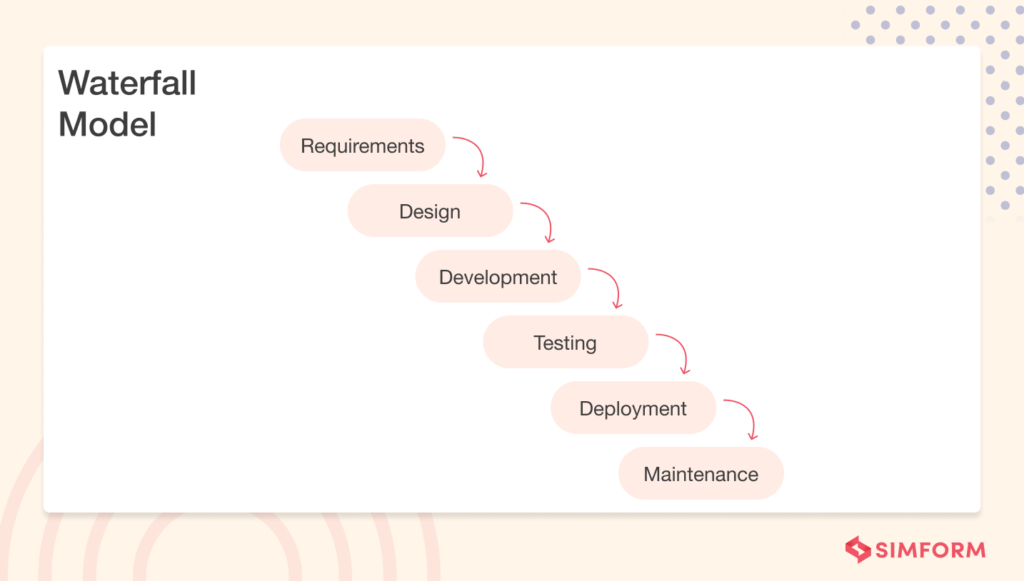
The waterfall is the oldest SDLC methodology used for the Software Development Life Cycle. It was first introduced in Winston Royce’s paper in 1970. And since the last 20 years, the waterfall methodology has been widely used by developers and software engineers across the globe.
As per the waterfall model, the software development process goes through all the software development lifecycle phases without any overlapping. It is a linear-sequential life cycle model, so any stage in the development process can begin only after completing the previous one. Teams are mainly large, and everyone on the team works within their silos.
The development team enters the coding phase of the software once the entire architecture, data structures, and functional software designs are ready. Only after then integration and validation will get started.
2. Agile
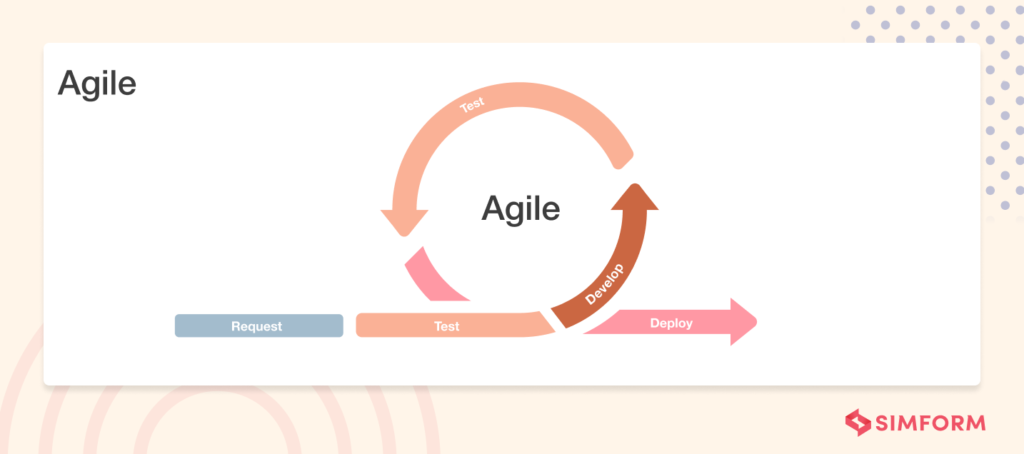
In 2001, around 17 software pioneers created the ‘Agile Manifesto’ as an alternative to eliminate the limitations of waterfall methodology. The software development lifecycle in the Agile approach treats design, requirements, and testing as a part of an existing process rather than time-consuming steps. As a result, the overall software development process becomes much faster.
Agile is gradually becoming a mainstream technology expanding its reach beyond coding. It is more focused on an interactive approach as it enables clients, developers, and testers to work together throughout the entire project. Overall, the agile model is suitable where minimal documentation is required, and the location is also the same.
3. Incremental
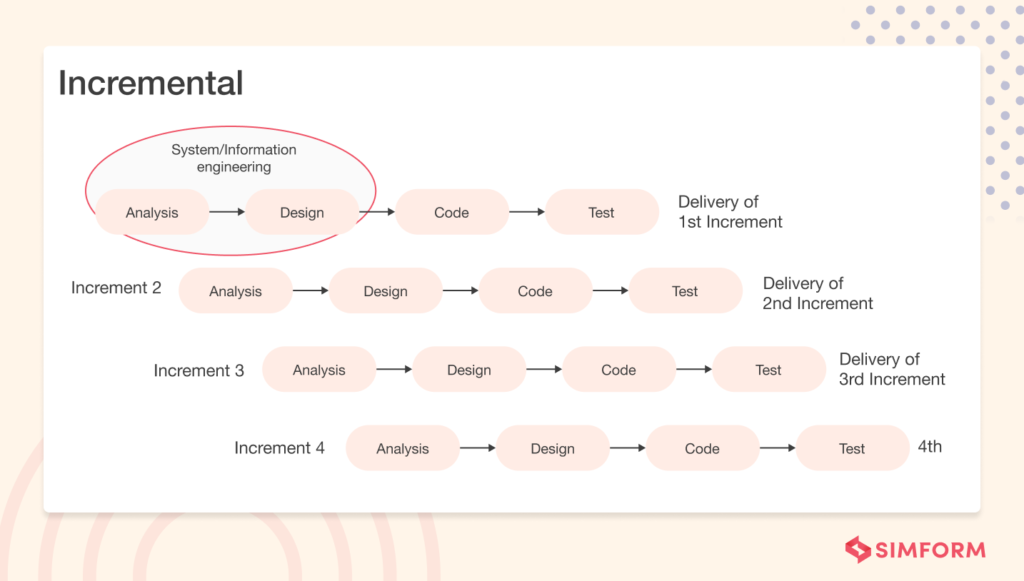
In the incremental model, developers can break down the software requirements into different standalone modules. Incremental software development contains multiple steps like high-level design, implementation, testing, and maintenance. Other than that, each iteration passes through the phases mentioned above.
After delivery of the first increment, the system goes into production. The first increment is often a core product where the developer addresses basic requirements and adds new features in the subsequent increments.
The software generation process has become much faster thanks to the incremental method. Moreover, this method is flexible enough as it leads developers to make changes at any stage of development. Also, clients can easily approach each build and quickly identify any errors.
4. Big bang
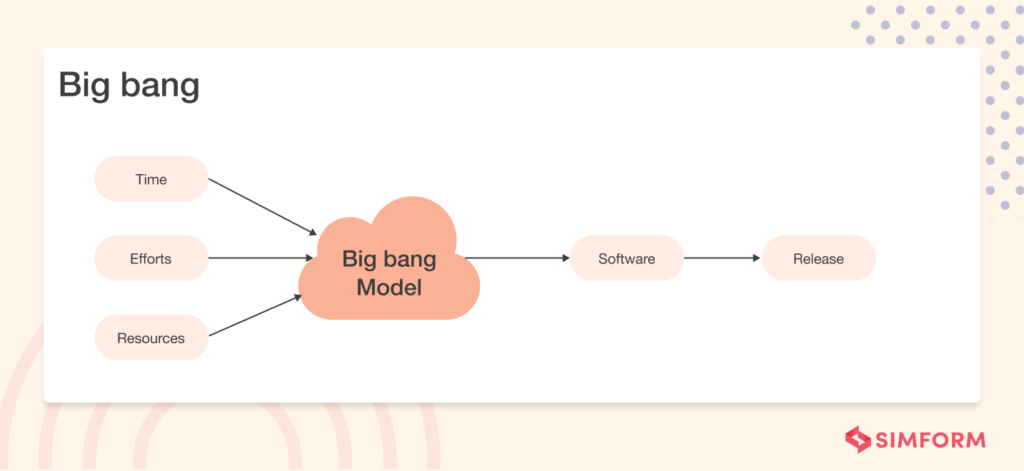
Big bang is the simplest model in the SDLC that does not follow any specific process and requires minimal time for planning. This model combines the efforts, time, and resources to build a product per customer requirements. However, it may happen that the end product might not meet the actual needs.
Generally, the big bang model is used for smaller development projects where only one or two engineers are needed. It helps new developers to develop their skills and gain some on-hand experience. In addition, the big bang model is cost-effective and does not require many resources and additional management staff.
5. Spiral
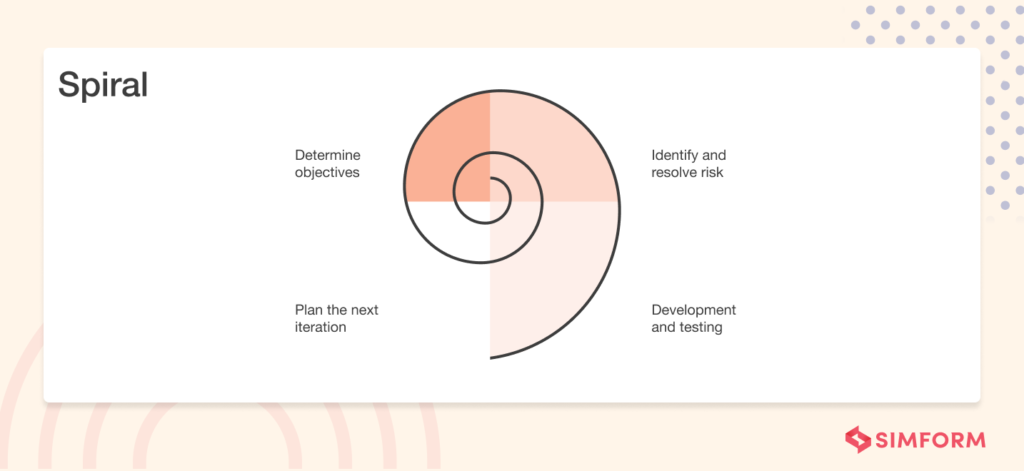
Barry Boehm introduced this term in his paper named “A Spiral Model of Software Development and Enhancement” in 1986. Touted as one of the most flexible methodologies, the Spiral Model takes a cue from the iterative model and its repetition.
Furthermore, a project passes through four phases — planning, design, development, and evaluation — over and over in a “spiral” form until completion. Besides that, the spiral model facilitates you in building custom software and implementing user feedback right from the beginning of the development process. As a result, it becomes easier to create a more user-centric product.
6. V-model
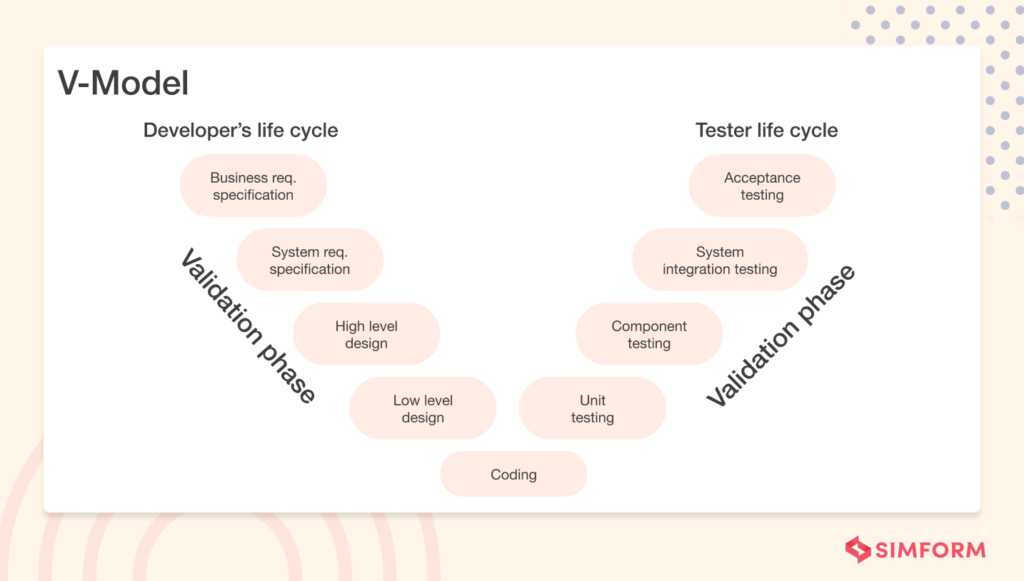
Derived from the Waterfall model, V-model is also called the Verification and Validation model for the SDLC process. Moreover, the V-model is characterized by a corresponding testing phase for every development stage. In a V-shaped model, every new step starts only after completing the previous one.
V-model is preferred when an expert-level technical team and resources are available. In this model, parallel testing ensures that all bugs and defects are known at the early stages. If any change is required, you should update the SRS document accordingly.
Real-life example of SDLC
We have discussed the steps for software development life cycle, and now we will look at the practical application of the software development life cycle process. This example is about building an eCommerce platform. Let’s look at the SDLC steps one by one:
- Planning: In the planning phase, the eCommerce project manager and business analyst will collect requirements from stakeholders regarding how the eCommerce platform will work and what features it requires. Then, they will create detailed SRS (Software Requirement Specification) documents. After this, the business analysts will get the SRS documents reviewed by the key policymakers and stakeholders to get them approved.
- Designing: The SRS documents will be sent to the eCommerce software development team at this stage. First, the development team will carefully review the document to understand client requirements. Then, eCommerce developers will build a suitable architecture, and designers will create web pages after approval.
- Development: Coders will take over eCommerce platform development in this phase. They will code the web pages and APIs required to add various functionalities.
- Testing: In this step, the tester will do end-to-end functionality testing. They will ensure that the e-commerce platform is working seamlessly without any bugs.
- Deployment: At last, the developers will deploy code and offer end-users the final version of the e-commerce solution. After that, a similar process will be followed while integrating the latest features.
Choosing the best model for SDLC
Selecting a suitable model for Software Development Life Cycle is a feat as very few organizations know the criteria for choosing the best SDLC model that adds value to their operations. Before considering a framework for a given SDLC methodology, we need to look at some steps to get the selection right –
- Gain enough experience and familiarity with the chosen model. Furthermore, you should know the context in which the SDLC model can fit.
- Study the stakeholder requirements, business domain, technical capabilities, and constraints.
- Analyze the suitability of the model against your team’s size and skills, projects, the technology that you are going to integrate, and your software engineering capability.
- Make a decision matrix that defines each option’s score and weight. Also, document and share this decision with the related stakeholders after analyzing the results.
- Continuously optimize the SDLC during the project execution and make necessary adjustments to cope with the changes. Depending on your enterprise or project needs, you can make your own SDLC model.
Closing thoughts
The Software Development Life Cycle is a systematic process to ensure end-product quality. Adhering to an appropriate and secure SDLC is essential for any project’s success. Yet, the software development journey contains various milestones and challenges too. Without a laid path and a sense of direction, the development efforts will likely fall apart.
Successful organizations can take this process to the next level to embrace changes more effectively. An expert like Simform helps you develop a clearly defined plan to achieve this goal. Simform offers advanced services that you can integrate into your SDLC to build products much faster.
In addition, our skilled developers can help you create an enterprise-grade development plan and help your team create a suitable level of software development life cycle security.So what are you waiting for? Get in touch with us today with your software development idea!
